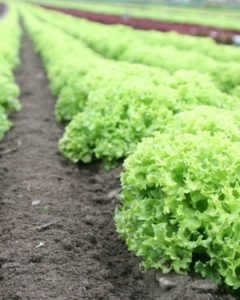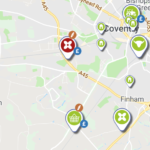What to do in your veg patch in July

Here is a great resource to help you grow great fruit and veg at home from our friends at Garden Organic. Like BigBarn Garden Organic work with schools to get kids growing veg and they are supporting our petition to get Food Growing on the national curriculum (please sign here).
So here is what they are suggesting to do in July:
July is the month when all the hard work pays off. Herbs and flowers are fragrant, and the soil rich with your home made compost. After the rush of May and June growth, you can relax a little and enjoy the fruits of your labour.
See below for advice on soil, vegetables and fruit.

Fresh chemical free lettuce
Cover all bare soil with mulches to prevent moisture loss. For instance, grass clippings piled thickly onto layers of newspaper (6 – 8 sheets). Before applying mulches, hoe off any weeds and water dry soil well. FS Managing your soil; Mulches: weed prevention and control
As you add material to the compost heap, mix greens (nitrogen rich) with browns (carbon rich) at a 50/50 ratio. Dry heaps will need watering. Turning the heap will aerate it and speed up decomposition. See Home Composting
If you have a worm bin, make sure it doesn’t get too hot and kill the worms. FS Worm composting
Vegetables
beans
If your first sowings failed, there is still time to sow lots more veg through July for late summer and autumn cropping (including French beans for a September crop).
Before going on holiday, hoe, weed and mulch to keep weeds under control and the soil moist, while you are away.
Sow a green manure crop if you still have large areas of bare ground. Suitable for this month are buckwheat, mustard, phacelia, crimson & red clover, fenugreek and trefoil.
Pest and disease watch
Beware of carrot fly when thinning carrots; the scent released from the bruised foliage will attract the pests. Use a fine mesh barrier to protect plants.
Also use fine mesh to protect brassicas from cabbage white butterflies. Check plants for eggs and caterpillars, and squash any on sight to reduce infestations. Ditto for peas and pea moth.
If slugs are a problem, check your traps, especially after rain. This could be a daily task. See Slug controls. Slug controls for organic growers are available from the Organic Gardening catalogue.
If dealing with aphids, remember washing up liquid is not soap, it is a powerful detergent designed to de-grease a frying pan. Plants’ tender new growth can be severely damaged if sprayed with a solution. It is better to squish aphids by hand (wear gloves if squeamish).
 Potato blight spores will wash down from the leaves into the soil. Protect tubers by earthing up plants, or mulching them with a thick layer of straw or leaf mould. If foliage is severely affected, it is better to defoliate completely to clear away the spores.
Potato blight spores will wash down from the leaves into the soil. Protect tubers by earthing up plants, or mulching them with a thick layer of straw or leaf mould. If foliage is severely affected, it is better to defoliate completely to clear away the spores.
Other pests and diseases to look out for include asparagus beetle, onion white rot, flea beetles in brassicas, allium leaf miners in onions, leeks and shallots. See Pests and Diseases for treatments. Also FS Flea Beetle, Potato Blight, Allium leaf miner, Leek Moth, Onion white rot, Slugs and Carrot Fly
Fruit
berried fruit
July is the month that the fruit garden comes into its own. However, once a crop has been harvested, remove protective nets to allow birds back in; they will continue to pick off pests over the rest of the summer.
Thin out apples and pears, particularly if you have a heavy crop. Firstly remove any diseased, damaged or unusually small fruits. Then carefully reduce numbers to no more than 2 or 3 per cluster. You will get larger sweeter fruits as a result.
 If you have not mulched under your strawberries with straw, do not delay. It helps to reduce grey mould (botrytis). Once fruiting has finished, cut off old leaves to prevent disease.
If you have not mulched under your strawberries with straw, do not delay. It helps to reduce grey mould (botrytis). Once fruiting has finished, cut off old leaves to prevent disease.
Summer prune red and white currants (not blackcurrants) and gooseberries. This allows more air circulation, lets light in to ripen the fruit, and reduces disease. Trim back all side shoots to 3 or 4 buds from their point of growth and cut out crossing shoots in the middle of the bush.
This is direct from Garden Organic’s website and has some great tips every month.

Your Local Food Map?
Many of our readers go on to grow their own crops, but often rather more than they really need for themselves. Please look out for places to sell your excess produce through our Crop for the Shop scheme here.
You will find places on our Local Food Map that have opted in with a carrot flag on their icon. You could even approach your local shop, pub or restaurant and supply them with fresh produce in return for a pint of beer or meal.
And please also advise them to join our map.